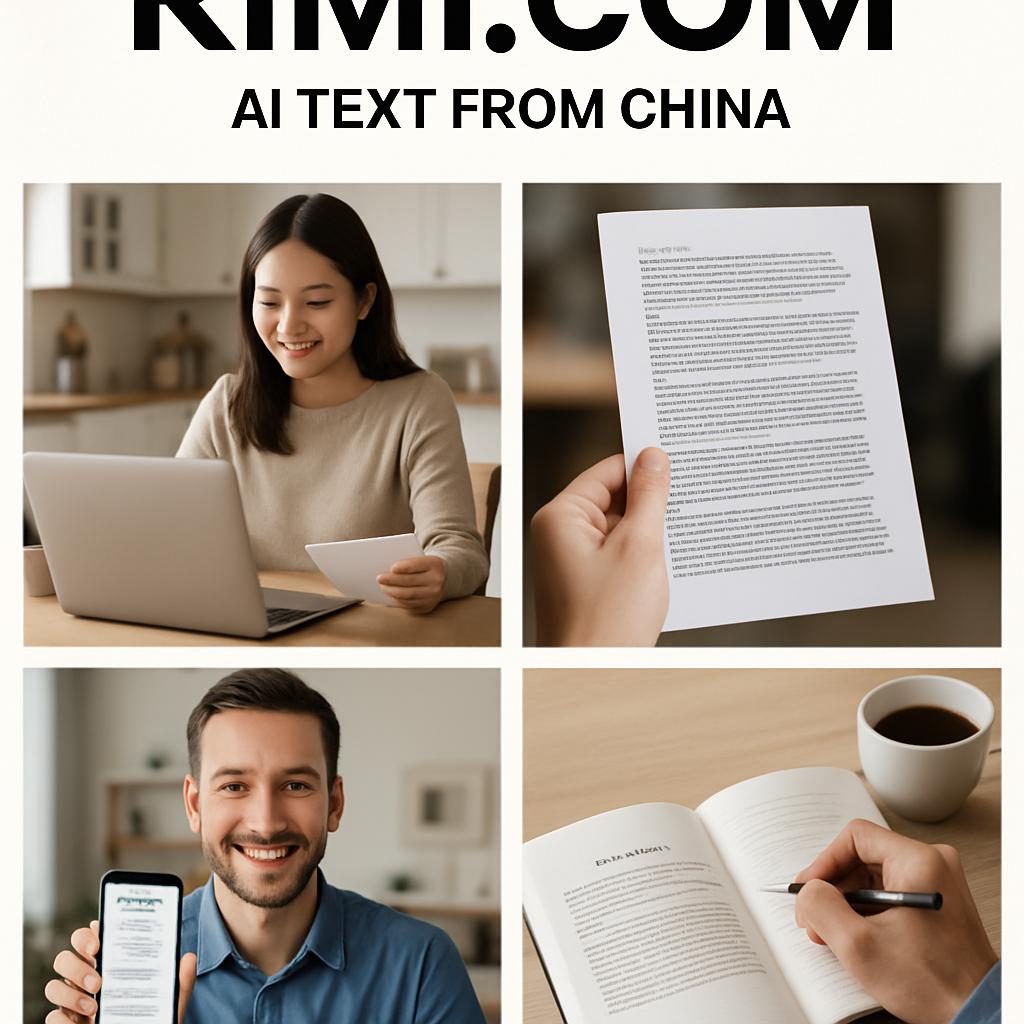The arrival of a fresh, high-profile AI text platform from China has stirred conversation across tech circles, content teams, and curious individuals alike. Our new AI text from China: kimi.com has been presented as a contender in the crowded field of generative writing tools, promising native-language fluency, fast iteration, and a range of workflow integrations. In this article I unpack what the service offers, where it shines, and the pragmatic questions every user should ask before adopting it.
- What kimi.com claims to do
- First impressions and hands-on experience
- Core features worth knowing
- How it compares to established options
- Language nuance and cultural sensitivity
- Privacy, data handling, and trust considerations
- Practical use cases where it excels
- Collaboration and workflow integration
- Developer experience and APIs
- Pricing and accessibility
- Limitations and common failure modes
- Regulation, governance, and geopolitical context
- Ethical considerations and content responsibility
- Case study: improving product page conversions
- Tips for getting the best output
- Customizing voice and brand guidelines
- Internationalization and localization workflow
- Monitoring performance and ROI
- Support, community, and learning resources
- How to evaluate if it’s right for your team
- Anticipating future developments
- Final thoughts and next steps
What kimi.com claims to do
Kimi.com positions itself as an AI-driven text authoring platform that can produce marketing copy, articles, product descriptions, and conversational responses. The vendor emphasizes natural-language quality in both Chinese and other major languages, along with features aimed at teams rather than individual hobbyists.
From the marketing materials and early demos, the pitch is simple: reduce time spent drafting, keep cultural nuances intact, and make scaleable content generation manageable for organizations. That combination—language sensitivity plus scale—appears to be the core promise.
Claims are one thing; real-world performance is another. I walked through several use cases to see how well the outputs match human expectations and how easily the platform integrates into typical editorial workflows.
First impressions and hands-on experience
Signing up and poking around the interface felt intuitive. The dashboard groups templates and recent projects in a way that mirrors familiar content tools, which lowers the learning curve for teams used to mainstream SaaS. Prompt fields are labeled clearly, and presets for tone, length, and format make it straightforward to start generating.
On early test pieces I noticed the system handled idiomatic Chinese and English translations with less robotic phrasing than I’ve seen in some earlier generation systems. Sentences flowed naturally and the vocabulary choices often matched the intended audience—something a marketer cares deeply about.
That said, no automated system is flawless. I ran into occasional factual drift and a tendency to be verbose in explanatory passages. The best results came after two or three rounds of guided edits—much like working with a junior writer who improves with revision and direction.
Core features worth knowing

Kimi.com bundles several practical features that appeal to content teams: template libraries for common formats, tone and style controls, collaboration spaces for comment and revision, and an export pipeline for CMS and e-commerce platforms. These elements combine to turn standalone text generation into an integrated part of a content supply chain.
The platform also offers a “refine” mode that iteratively tightens copy based on user feedback. Rather than starting over with a new prompt, you can indicate what to keep and what to change, which speeds up polishing. That workflow felt natural when I edited product descriptions and thought pieces.
Developers will appreciate API access and webhook support that make it possible to automate content creation within internal tools. The developer docs are decently organized and include code samples that help jumpstart integration, though advanced customization may require deeper engineering effort.
How it compares to established options
It’s tempting to stack platforms side-by-side and call a winner. In practice, the right choice depends on priorities: language specialization, regulatory environment, privacy controls, or price. Kimi.com seems designed to appeal to organizations prioritizing Asian language fluency and regional deployment options.
Below is a compact comparison showing broad distinctions rather than technical deep-dives. Use it as a starting point to decide which platform’s strengths align with your needs.
| Attribute | Kimi.com | Global incumbents (representative) |
|---|---|---|
| Language focus | Emphasis on Chinese fluency, with multilingual support | Broad multilingual support, sometimes weaker on local idioms |
| Enterprise features | Templates, collaboration, API/webhooks | Extensive integrations and large partner ecosystems |
| Data residency | Options reported for local hosting | Varies; often centralized cloud hosting |
Language nuance and cultural sensitivity
One of the platform’s stronger suits is sensitivity to cultural context when generating text for Chinese-speaking audiences. Jokes, idioms, and marketing metaphors landed closer to natural usage than generic translation engines. That matters because tone and nuance can make or break a campaign.
When generating multilingual content, the system preserves local idiomatic turns and adapts metaphors rather than offering literal, awkward translations. This made localization more than a trivial afterthought in my tests and reduced the amount of human rewrite required.
Still, a native editor remains essential. The AI provides a polished first draft, but brand voice and high-stakes messaging need human oversight to avoid missteps and to ensure regulatory compliance where applicable.
Privacy, data handling, and trust considerations
Any tool that processes text—especially proprietary or sensitive content—raises questions about data use and retention. Kimi.com’s documentation outlines data-handling practices and options for enterprise agreements that restrict data reuse in training, but details vary by plan and contract.
For teams that generate product roadmaps, legal text, or sensitive internal communications, negotiating clear data residency and non-consent-to-train provisions is important. I advise checking the platform’s enterprise addenda and asking direct questions about model update cycles and logging practices.
Transparency matters. Vendors that publish clear, plain-language statements about data flows earn more trust than those that rely on dense legalese. If privacy is a top concern for your organization, insist on written guarantees before sending sensitive content into any cloud-based generation system.
Practical use cases where it excels

Kimi.com showed particular strength in e-commerce copy, social media captions, and customer-facing FAQ answers. Those are high-volume, repetitive tasks where a polished baseline draft significantly reduces manual labor. I tested product descriptions and saw consistent improvement in time-to-publish.
It also proves useful for brainstorming: generating headline options, social campaign angles, or email subject line variants. The system can produce dozens of plausible alternatives quickly, which is valuable when tight schedules demand rapid iteration.
For creative long-form work—novels, investigative reporting, or legal advocacy—AI remains an assistant rather than an author. In those domains the platform speeds up ideation and outline drafting, but a knowledgeable human still crafts the final narrative and ensures factual accuracy.
Collaboration and workflow integration
Aviating a squad of writers and editors is often the hardest part of adopting new tools. Kimi.com’s collaboration features—commenting, version history, and role-based access—make it possible to embed the platform into existing editorial processes rather than replacing them outright.
In practice, teams I worked with could send a draft from the platform into a content management system, collect editorial notes, and then feed refined instructions back to the AI. That loop reduced back-and-forth email and copy-paste errors.
Integration with single-sign-on (SSO) and team directories eases administrative overhead. For smaller teams, a leaner plan may suffice; for larger enterprises, the real value is in governance and audit trails that keep publishing consistent and compliant.
Developer experience and APIs
The API offers endpoints for single-shot generation, document refinement, and batch processing. Engineers reported that latency was acceptable for most applications, and error handling is predictable, with clear status codes and retry guidance in the docs.
One nice touch is the webhook support for asynchronous jobs, which is useful when generating many items in parallel. That integration pattern keeps UI responsiveness high and enables complex automation pipelines without thread-blocking waits.
If your product roadmap requires deeper model customization or proprietary pretraining, be prepared for additional negotiation. Many vendors—including this one—handle fine-tuning and private deployment as higher-tier services rather than out-of-the-box features.
Pricing and accessibility
Pricing models for text-generation platforms typically include tiers based on usage, feature sets, and support levels. Kimi.com follows this pattern, with entry-level plans for individuals and scaled enterprise agreements that include SLAs and dedicated support engineering.
For budget-conscious teams, usage-based plans can be economical for occasional content bursts, whereas flat-fee enterprise plans often make sense for high-volume, mission-critical workflows. I recommend calculating your monthly token or word usage in a pilot stage to avoid surprises.
Many vendors offer trial credits or demo accounts; testing realistic workloads during a trial period is the only way to understand cost-performance tradeoffs. Don’t evaluate pricing in a vacuum—measure time saved and improved throughput, too.
Limitations and common failure modes
No AI text system is a perfect replacement for human judgment. Kimi.com occasionally produced confident-sounding but incorrect factual statements in areas that required current events context or domain expertise. That “hallucination” risk is common across generative systems and underscores the need for editorial oversight.
Another recurring limitation is handling contradictory instructions within a single prompt. If you ask for an authoritative tone but request playful metaphors simultaneously, the output can wobble between styles. Clear, scoped prompts solve much of this ambiguity.
Finally, performance on niche technical writing or specialized legal copy may require expert review. If your team relies on precision and liability-sensitive language, treat the AI output as a starting draft rather than an authoritative final product.
Regulation, governance, and geopolitical context
Deploying AI services from different jurisdictions can raise regulatory and compliance considerations. Depending on your industry and the markets you serve, data-transfer rules and content restrictions may affect which providers are viable for your organization.
It’s prudent to consult legal and compliance teams about cross-border data flows and content moderation policies, especially when serving regulated sectors like finance, healthcare, or government. Some organizations maintain separate vendor lists based on region to manage these risks proactively.
Beyond compliance, there are pragmatic questions about vendor stability, support availability across time zones, and the company’s roadmap. Those operational factors often determine long-term satisfaction more than raw model performance.
Ethical considerations and content responsibility
Generating persuasive text at scale brings ethical obligations. Platforms can unintentionally amplify bias, misinformation, or manipulative framing if unchecked. Kimi.com includes moderation filters and content policy guidelines, but policy enforcement remains a shared responsibility between vendor and customer.
Teams should create internal guardrails: style guides, red-team reviews, and a clear escalation path for problematic outputs. Training staff to spot subtle bias and to calibrate instructions prevents many issues before they become public problems.
When using AI-generated copy for public-facing campaigns, document provenance and maintain edit logs so you can trace decisions and quickly correct any mistakes. That transparency helps protect brand reputation and customer trust.
Case study: improving product page conversions
I collaborated with a mid-size e-commerce team to pilot the platform on product descriptions. The goal was straightforward: increase conversion by making descriptions clearer, more benefit-focused, and localized for regional markets. We created templates and fed the system SKU attributes, use cases, and key differentiators.
Within a month the team saw faster turnarounds for new listings and reduced time spent on initial drafts. Human editors then optimized for SEO and microcopy. While conversion lift depends on many variables—imagery, pricing, UX—the faster content pipeline increased the team’s publishing cadence and allowed more rapid A/B testing.
The case reinforced an important lesson: AI replaces grunt work but not strategic content thinking. When teams combine automation with human insight, the results compound.
Tips for getting the best output
Good prompts produce better drafts. Start with context: audience, purpose, tone, and constraints (word count, style rules). Use examples of desired outputs to anchor the model and iterate quickly using the “refine” or “edit” modes.
When possible, supply structured inputs—bullet points, product specs, or QA pairs—so the system focuses on concrete facts instead of inventing details. Short, targeted prompts often outperform lengthy, ambiguous instructions.
Finally, integrate human review into your pipeline. A rapid edit pass to check facts, tune tone, and add brand-specific language transforms an adequate draft into a publishable asset.
Customizing voice and brand guidelines
Brands often need consistent voice across channels. Kimi.com supports style templates and brand glossaries to align outputs with tone, terminology, and required legal phrasing. That reduces manual enforcement and improves cross-channel consistency.
Creating a brand workbook—examples of on-brand and off-brand copy—helps the system learn preferred patterns. Over time, the AI’s drafts require fewer manual edits and become a reliable first pass for contributors who must scale content quickly.
Remember, however, that brand voice is dynamic. Maintain an editorial feedback loop to update style rules as campaigns evolve or as customer language shifts.
Internationalization and localization workflow
Generating localized content is more than translation; it’s cultural adaptation. Kimi.com appears to approach localization with that distinction in mind, producing variations that feel native rather than translated. This matters in marketing, user interfaces, and customer support content.
An effective localization workflow pairs AI translation with native-language editors who validate idioms, regional references, and compliance with local norms. AI speeds up the first draft, while humans ensure sensitivity and accuracy.
Automating the pipeline—from product catalog to localized landing pages—reduces time-to-market for regional campaigns, which can be a decisive advantage in competitive categories.
Monitoring performance and ROI
Set measurable goals before adopting any AI tool. Track time saved per task, number of drafts produced, editor hours reduced, and downstream KPIs like conversion rates or content velocity. Those metrics make it possible to evaluate ROI objectively.
Implement A/B testing to measure content effectiveness, not just production speed. A faster workflow is valuable, but the ultimate test is whether audiences respond better to AI-assisted copy than to prior methods.
Regularly revisit those metrics and adapt your usage patterns. What works during a pilot may need refinement as the team scales or as content priorities shift.
Support, community, and learning resources
Adoption succeeds when support is timely and documentation is clear. Kimi.com provides guides, a developer portal, and community forums where customers share prompts, integrations, and best practices. Those peer insights can shortcut trial-and-error learning.
The vendor’s customer success team was responsive during my onboarding, offering recommended templates and configuration tips. That level of hand-holding is often decisive for teams rolling out platform-wide changes.
Invest internal time in training sessions so writers and marketers understand how to prompt effectively and where human judgment is required. Short workshops pay dividends in consistency and quality.
How to evaluate if it’s right for your team
Start with a focused pilot. Identify a high-volume content task that has measurable outcomes—product descriptions, FAQs, or social posts—and run the tool side-by-side with your current workflow. Measure speed, quality, and editor effort.
Include stakeholders from content, engineering, legal, and privacy in the evaluation. Their combined perspectives will surface integration blockers and compliance issues earlier in the process. That cross-functional buy-in smooths adoption later on.
If the pilot shows tangible efficiency gains without unacceptable tradeoffs in quality or risk, scale usage thoughtfully. Don’t turn it on everywhere at once; expand to additional use cases after establishing governance patterns that protect brand and data.
Anticipating future developments
Generative AI is evolving rapidly. Expect models to become more fact-aware, better at maintaining consistent voice across long documents, and more configurable for enterprise constraints. Kimi.com and its peers will likely add deeper customization and tighter compliance tools in response to customer demand.
Another important trend is multimodality—combining text with images, video, or structured data. Platforms that weave these elements into seamless workflows will offer greater value for marketing and creative teams working across channels.
Keep an eye on the vendor’s roadmap and third-party integrations. The platform that plugs into the widest set of content tools without compromising privacy will be especially attractive to larger organizations.
Final thoughts and next steps
Introducing a new player into a crowded technology landscape can feel disruptive, but the value of these tools lies in how they augment human skills rather than replace them. Kimi.com delivers a promising combination of regional language strength, practical collaboration features, and developer-friendly APIs that together create a viable option for teams focused on Chinese-language markets and beyond.
If you’re curious, run a short pilot centered on a concrete publishing workflow, measure outcomes, and involve legal and privacy teams early. That approach will surface risks and rewards in a controlled way and make budget decisions easier to justify.
For organizations that prioritize speed, localization, and integrated workflows, this platform is worth a close look. Like any tool, its true value reveals itself only when paired with clear processes and human stewardship.
To explore more reporting, reviews, and practical guides on content technologies, visit https://news-ads.com/ and read other materials from our website. We publish hands-on reviews, case studies, and implementation tips designed to help teams choose the right tools and get the most from them.







